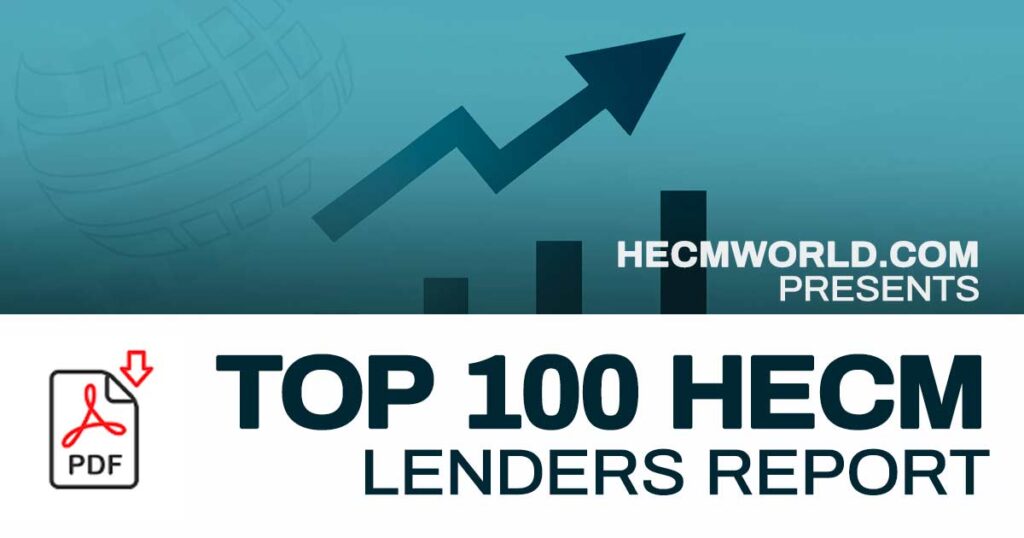
Download your September 2018 Top 100 Retail HECM Lenders Report Here.
Share:
Leave a Comment
Must Read:
Recent Stories
Topics
Employees of the CFPB will have a lot of time on their hands. Scott Bessent,...
One Illinois scammer was so prolific in victimizing older homeowners tricking them into a reverse...
A look at President Trump’s recent executive order addressing America’s housing affordability crisis and what...








4 Comments
HUD’s fiscal year just ended. Total endorsements in fiscal year 2018 ended yesterday (9/30/2018) were 48,359. Even though the total is only 509 (just 1%) less than the endorsement total for fiscal 2016, the total endorsements for fiscal 2018 was the worst such total for any fiscal year since fiscal 2005.
This is the sixth straight fiscal year of slightly downward sloping peak to valley secular stagnation. That comes right after three severe years of loss in HECM fiscal year endorsement counts in fiscal years 2010, 2011, and 2012.
The largest statistical vendor on HECM endorsements to the reverse mortgage industry declared on June 6 that the endorsement losses following the issuance of Mortgagee Letter 2017-12 resulting in the HECM changes on October 2, 2017 bottomed with the April 2018 endorsement count. Yet the count for June 2018 (the month of the announcement) was over 15% lower than the April 2018 count. Yet once again last week, that same statistical vendor stated that a 2.9% rise in endorsements for July 2018 showed that June 2018 was the nadir following the 10/2 changes. Yet the endorsements for September 2018 was 1% lower than the endorsement count for July 2018 and 10% lower than the endorsement count for August 2018 but most importantly the September 2018 count was 42 endorsements higher than the endorsement count for June 2018. So June 2018 is the lowest endorsement monthly count for fiscal 2018 and with the endorsements for the month of September 2018 coming in as the second lowest.
The endorsement count for fiscal 2018 was 12.5% lower than the endorsement count for fiscal 2017. 62% of the endorsements for fiscal 2018 were generated in the first half of the fiscal, making the last six months of fiscal year 2018, one of the worst. Not since March 2004 have we seen two straight calendar quarters total less than the total of 18,527 which was the total endorsements for the last half of fiscal 2018. Not since June 2005 have we seen one calendar quarter of less than 10,000 endorsements and not since June 2004 have we seen two straight calendar quarters of less than 10,000 endorsements as was true of the last two fiscal quarters of fiscal 2018. This means for a anecdotally declared recovery, the facts point to monthly endorsements moving in the wrong direction.
Perhaps one of the worst signs for fiscal 2019 is that total endorsements for the quarter ended September 2018 was lower than for the quarter ended June 2018. It is so low that the last time that total endorsements for a calendar quarter were lower than 8,985 (total for last quarter of fiscal 2018) was December 2003. The total case number assignment inventory reported by HUD is 9,052 for the first two months of fiscal 2019 and with a conversion rate of just 64%, the expected endorsements for the first two months of fiscal 2019 will be about 5,800 for an annualized total of under 35,000. It is quite possible that the first quarter of fiscal 2019 will have less endorsements than for the quarter that just ended. While I believe that the total endorsements for fiscal 2019 will be closer to 48,000 than 35,000, it seems that our current peak to valley pattern of slightly downward sloping secular stagnation ended with fiscal 2018, otherwise we will need about 51,000 endorsements for fiscal 2019 (which seems unlikely right now) to see the current pattern of secular stagnation continue.
Good Morning? Good day, good month? Mr. Veale, the bearer of good tidings as usual. Facts and figures that proof out what the people on the ground are feeling. Gut wrenching truth. I closed one loan in September, the first since May. It was a very clean loan. Free and Clear. No income or credit issues. They opened a line of credit, and took out $20,000 at closing for a total loan amount of $36,000.
I made a bit of money, but did not do it at the customer’s expense by charging a higher margin and giving them less monies.
The age old question asked by the wife was ” What is this 6,000 dollar charge?”. I said the upfront mortgage insurance. We had talked about that cost at length at proposal and application, but she still did not remember that fee. She did not want to remember that fee. They are both VERY frugal.
But she remembered and we closed and funded.
These are the types of loans I am getting if they come along at all. Either great clean loans, or a manufactured home in Apache Junction with engineering issues and potable water trucked in to the community among about 10 others with issues that we all know.
Too high mortgage balances to pay off and no other assets. The principal limit tightens the funnel.
HUD has squeezed this loan close to death. And Montgomery is concerned about the secondary market. He should be. But that should not be his first concern.
The upside down calculations, makes it unscrupulous. That is the worst of it.
And now the new second appraisal. That will be easy to explain.
All I can say is I am glad that I practiced what I have preached all of these years to my clients. I could see the writing on the wall when the FA was implemented. The days were numbered and Veale proves it again by the numbers. Something has to give. The new proprietary products? LTV ? does not help much. But worth a try. Adios.
Hey Robin,
I can only present what the numbers dictate and those are dependent on what the market produces.
It seems even our friends at NRMLA are so over focused on what will bring down ACTUAL losses in the MMIF rather than the projected losses (the higher percentage of HECM losses reported in the MMIF), that HUD has accepted an additional procedure that long-term will end with even lower endorsements.
To gain back higher PLFs, it is my strong belief that based on the limitations of conventional wisdom, PLFs must be lowered further until there is sufficient proof that projected losses are not representative of lower actual losses. Yet I have little faith in actual losses will be much lower than those projected.
The way to fix the problem is to move to a different system for determining PLFs. Both Shannon and I promote this change which Shannon named Geocentric PLFs. For those with a more Socialistic outlook, this might seem brutal since those living in higher appreciation areas would be offered higher PLFs than those living in areas where appreciation rates are lower despite the MIP structure not changing from now. Yet the theoretical result of this restructuring would be to match risk with recent historical appreciation rates. As to projections, MMIF losses should be greatly mitigated on future new books of fiscal year business. While that would still leave the current $14.5 billion HECM MMIF losses to deal with, at least HUD could provide annual reports to Congress showing a much stronger policy in place to mitigate future losses. Without substantial changes in projection estimates and assumptions, there is little way to effectively lower the current $14.5 billion HECM MMIF losses without a capital infusion from Congress. A (stratified) geocentric approach creates a situation where the HECM program addresses the underwater risk.
The geocentric method will be a two step process. Let us assume that the originator is trying to give the borrower a strong estimate of the principal limit her lender can provide. The first step would be to determine what geographic category the borrower’s home lies in which HUD would create. Then based on that category, the originator would go to the related PLF table and the originator would determine the PLF available for the HECM just as originators do now. The difference is that rather than a national PLF table, there would be four to six PLF tables.
The geographic categories would be based on a five year (or some other period HUD determines is better) appreciation rate average, with the possibility of areas being recategorized as frequently as quarterly, semi-annually or even annually (to be selected by HUD). So the lower the average appreciation rate, potentially, the lower the PLFs available to the borrower. This may include homes in areas where appreciation rate growth is negative to say 0.5% positive. The second could be those with 0.5% average appreciation rates to 1.25% and would have better PLFs available to homeowners in those areas than available to the first group. The final group might include areas with over 4% appreciation using PLFs available in say fiscal 2010 until it is proven this system works at which time, PLFs for the category with the highest average appreciation rates could return to the PLFs available to borrowers on 9/30/2008.
Yes, we expect resistance but no really innovative idea that works is without its detractors.
I like the geocentric idea. I bet it could be implemented fairly easily. We had that back in the day with the FHA loan limits in different areas. But, I love your mind, I think.
The new proprietary loans are great to an extent. My manager is working on two. $1.2 million and $2.9 million. Ha. If you can’t beat them, leave them in the dirt. And even with these loans, the borrower only gets a low LTV. But NO MIP. And in some instances no origination and possible no fees. Big monies on the back make that possible. We used to be able to do that with the HECM. That is over. For me anyway.
My manager is very happy right now.